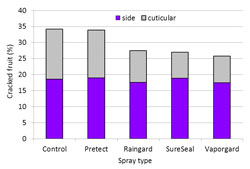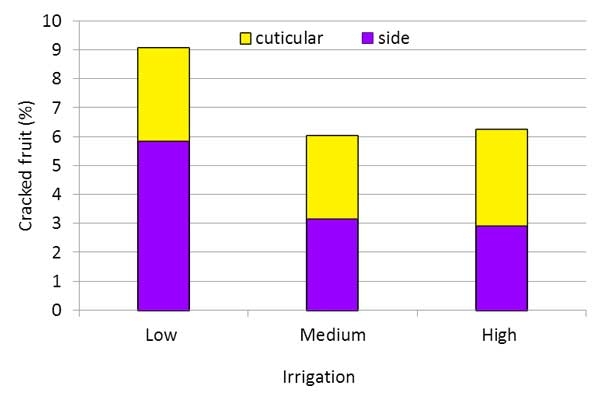Results continue to show promise. “Improving marketable yield of premium quality fruit” is possible.
Two successful seasons of this HAL–funded project run by the Tasmanian Institute of Agriculture have shown it is possible to reduce cracking and improve yields without losing quality.
2010–11
The 2010–11 season showed that spray applications, high crop loads, high volumes of irrigation and removing extension growth during a rainfall event all reduced cracking significantly.
Cracks in the cuticle at the top and the base of the fruit were reduced with sprays and high crop loads; and large side cracks in the flesh of the fruit were reduced under high irrigation, and with extension pruning.
2011–12
The 2011–12 season has again yielded reductions in cracking, and the project can now provide more confidence in the initial results.
Several very large trials were completed this past season and strategies again focused on four key areas:
- crop load manipulation
- spray treatments
- selective pruning
- irrigation.
In addition, treatments were combined to assess interactions between strategies.
Trial & treatments
A large trial (360 trees) considering the combined impact of crop load, timing of thinning, pruning and spray applications was undertaken on variety Sweetheart.
Treatments included:
- A low, medium and high crop load, achieved by hand thinning each spur to 1, 2 or 4 floral buds respectively.
- Thinning at pre or post-bloom—dormant buds in winter, and fruit four weeks after full bloom (close to pit-hardening).
- Pruning extension growth just prior to a rainfall event during the last week of fruit maturity.
- Five spray treatments—Pretect, RainGard™, SureSeal, VaporGard® and a control.
 Results: sprays
Results: sprays
As with the 2010–11 season, there was a significant reduction in cuticular cracking with all sprays, which accounted for the overall reduction in the total amount of cracked fruit.
The sprays, VaporGard, RainGard and SureSeal were all particularly effective in this regard (see Figure 1).
There were no interactions between the combined treatments. This means one strategy did not influence the outcome of another. For example, the sprays were neither more nor less effective under different crop loads.
Results: crop load
The crop loads achieved under the different thinning regimes were significantly different, and the higher crop loads again saw less total cracking—mostly through a reduction in cuticular cracks (see Figure 2).
This season there was no effect of crop load on side cracks, and no reduction (or increase) in cracking was seen with pruning of extension growth, however, the timing of pruning was different.
Results: removing extension growth
The 2010–11 reduction in cracking resulted from removal of extension growth one week prior to harvest during a rainfall event.
This season (with 180 trees to prune) removal during a rainfall event was not possible. Instead, pruning was undertaken the day prior to a rainfall event—this had no impact on cracking levels.
Results: summary
Thus, using sprays and maintaining crop load, again come out as viable techniques to reduce cracking.
Without spray treatments the equivalent of 2.3 t/ha of fruit was lost due to cracking.
The best performing spray treatment reduced this loss to 1.9 t/ha. Furthermore, fruit quality does not seem to suffer under these treatments—marketable yield can be improved by reducing cracking.
In fact, some sprays significantly increased the average fruit size (see Table 1).
Very little difference was noted in flesh texture, skin puncture force or fruit firmness. More importantly, the increase in size is not just significant on paper, but actually increased the number of trees with fruit in the larger class sizes (see Figure 3) therefore having the potential to increase margins.
This season, removing extension growth on a larger scale was trialled by heading using a cutter bar.
This was undertaken three weeks prior to harvest.
Unfortunately (for the trial) there was no rain following this treatment, and no cracking observed.
The treatment did however increase sugars and firmness (see Figure 4).
Removing the extension growth was also trialled at different growth stages (during Stage II, and one week prior to harvest during Stage III) and cracking incidence and fruit quality was compared to trees with no pruning or removal of extension growth.
Side-cracked fruit was significantly reduced in trees which had been pruned in the later stages, and these trees also produced fruit with more sugars.
However, pruning at Stage II had the opposite effect—increased cracking and reduced sugars (see Figure 5).
Results: irrigation
Fruit from trees under low irrigation (50% standard grower application) again exhibited significantly more side cracks this year (see Figure 6).
The reduction in side cracks contributed to the overall reduction in cracking in this trial.
Furthermore, over two consecutive years now, low irrigation resulted in fruit with a higher cracking index value.
Fruit properties under the different volumes of irrigation are shown in Table 2.
Trees under high irrigation (150% standard grower application) produced larger fruit, and fruit from both the high and low irrigation treatments showed significantly higher firmness and skin puncture force properties.
Conclusion
These results, combined with previous research undertaken in the last few years, is now leading towards a more comprehensive understanding of management of cracking in Australia.
There are practical techniques available to build some resilience to late season rainfall.
Results will now be further assessed to incorporate seasonal climatic differences.
Comments and feedback from growers is welcome.
Cracking is a complex and interesting phenomenon, and any experience of cracking contributes to understanding and future research direction.
For information, figures and tables; and to contact Dr. Penny Measham, download the August 2012 issue of Tree Fruit magazine.




















